Associate Professor of Chemistry & Biochemistry

Jonah W. Jurss, Associate Professor of Chemistry and Biochemistry
379 Coulter Hall
662-915-2003
jwjurss@olemiss.edu
EDUCATIONAL AND PROFESSIONAL BACKGROUND
B. S. Chemistry with Honors
North Carolina State University, 2005
Ph.D. Inorganic Chemistry
University of North Carolina at Chapel Hill, 2011
Advisors: Profs. Thomas J. Meyer and Joseph L. Templeton
Postdoctoral Research Associate
University of California, Berkeley, 2011—2014
Advisor: Prof. Christopher J. Chang
Assistant Professor
University of Mississippi, 2014—2020
Associate Professor
University of Mississippi, 2020—present
PROFESSIONAL RECOGNITION
National Science Foundation Faculty Early Career Development (CAREER) Award
Michael Edmonds New Scholar Award
RESEARCH INTERESTS
Solar energy conversion, artificial photosynthesis (H2O oxidation, CO2 reduction), electrochemical and light-driven catalysis, surface attachment, mechanistic studies
GROUP WEBSITE
RESEARCH OVERVIEW
The Jurss Laboratory is an interdisciplinary research team that focuses on developing and understanding new earth-abundant catalysts for converting renewable energy (sunlight or clean electricity) into useful chemical fuels and for the selective functionalization of hydrocarbons to streamline organic synthesis. We are currently recruiting motivated graduate students and undergraduates to join our lab! If you are interested in our research, please contact Dr. Jurss by email. More information can also be found on our group’s website.
REPRESENTATIVE RESEARCH AREAS
Molecular Catalysts for Renewable Fuels: Electrochemical and Light-Driven Carbon Dioxide Reduction
Economic growth and an increasing global population continue to drive worldwide energy consumption to new heights. This energy is largely sourced from fossil fuels, whose combustion releases greenhouse gases that contribute to climate change and other environmental concerns. Carbon dioxide is the chief component of this waste stream and a readily accessible C1 building block for generating value-added products. In this context, the catalytic conversion of carbon dioxide (CO2) and water (H2O) into chemical fuels, such as methane, using solar energy or renewable electricity is an attractive strategy. By recycling CO2 back into renewable fuels or commodity chemicals, net carbon emissions can be reduced and an underutilized resource can be tapped into.
To effectively utilize CO2, better catalysts are needed to mediate its multielectron conversion. However, CO2 is relatively inert and very negative voltages or strong chemical reductants are common for its conversion. An additional challenge lies in achieving this reaction in water where aqueous protons are utilized selectively for CO2 reduction rather than hydrogen generation. Our strategy for CO2-to-fuel conversion involves the rational design of homogeneous catalysts with redox-active and/or dinucleating ligands, which enable access to multiple reducing equivalents at modest potentials and cooperative modes of CO2 activation, respectively. Second-coordination sphere functionality will also be incorporated to stabilize intermediates and enhance reactivity.
Water Oxidation and Hydrocarbon Functionalization with Robust Metal-Oxo Catalysts
High-valent metal-oxo species are potent oxidants in chemistry and biology for a variety of reactions, including the oxidation of water and hydrocarbons. Water oxidation is the oxidative half reaction in nearly all schemes for artificial photosynthesis. The decomposition of H2O to O2 supplies the protons and electrons needed in reductive half reactions that convert and store solar energy in the form of chemical bonds. Belying the structural simplicity of the starting material and product, water oxidation is a demanding multi-electron/multi-proton reaction. A lack of efficient and earth-abundant catalysts for water oxidation has been a bottleneck to solar fuels.
Likewise, hydrocarbon oxidation is an important class of reactions with the potential to streamline organic synthesis. Raw chemical feedstocks, such as petroleum and natural gas, are primary sources of inexpensive hydrocarbons for the chemical and pharmaceutical industries. However, they have thermodynamically stable, kinetically inert C−H bonds that are not often viewed as chemical handles for further manipulation. A challenge lies in converting these readily available feedstocks into versatile organic building blocks in a mild and atom economical manner. Circuitous synthetic routes engrossed in the maintenance and interconversion of functional groups throughout a reaction sequence can be avoided with catalysts capable of selective C−H bond functionalization.
Despite the remarkable progress that has been made to demonstrate the scope of chemistry available to synthetic metal-oxo catalysts, significant improvements in catalyst activity, selectivity, and stability are needed to realize the full potential of these systems. To overcome these limitations, we aim to develop new mononuclear and dinuclear metal-oxo catalysts with oxidatively-rugged ligands that enforce more reactive structures.
Bioinspired Chemistry on Surfaces
Nature tightly regulates the environment around metalloenzyme active sites to achieve catalysis with high efficiency and selectivity. This environment, comprised of specific noncovalent interactions such as hydrogen bonding, is referred to as the second-coordination sphere and plays a key role in orchestrating reactivity at the first-coordination sphere. We seek to mimic this concept on electrode surfaces to develop scalable catalytic systems to manage proton inventories, stabilize intermediates, and direct reaction pathways.
RECENT PUBLICATIONS
Talukdar, K.;# Sinha Roy, S.;# Amatya, E.; Sleeper, E. A.; Le Magueres, P.; Jurss, J. W. Enhanced Electrochemical CO2 Reduction by a Series of Molecular Rhenium Catalysts Decorated with Second-Sphere Hydrogen-bond Donors. Inorg. Chem. 2020, 59, 6087-6099. (# co-first authors)
Rodrigues, R. R.; Lee, J. M.; Taylor, N. S.; Cheema, H.; Chen, L.; Fortenberry, R. C.; Delcamp, J. H.; Jurss, J. W. Copper-Based Redox Shuttles Supported by Preorganized Tetradentate Ligands for Dye-Sensitized Solar Cells. Dalton Trans. 2020, 49, 343-355.
Su, X.; McCardle, K. M.; Chen, L.; Panetier, J. A.; Jurss, J. W. Robust and Selective Cobalt Catalysts Bearing Redox-Active Bipyridyl-NHC Frameworks for Electrochemical CO2 Reduction in Aqueous Solutions. ACS Catal. 2019, 9, 7398-7408.
Talukdar, K.; Issa, A.; Jurss, J. W. Synthesis of a Redox-Active NNP-type Pincer Ligand and its Application to Electrocatalytic CO2 Reduction with First-Row Transition Metal Complexes. Front. Chem. 2019, 7, 330.
Shirley, H.; Su, X.; Sanjanwala, H.; Talukdar, K.; Jurss, J. W.; Delcamp, J. H. Durable Solar Powered Systems with Ni-Catalysts for Conversion of CO2 or CO to CH4. J. Am. Chem. Soc. 2019, 141, 6617-6622.
Liyanage, N. P.; Yang, W.; Guertin, S.; Sinha Roy, S.; Carpenter, C. A.; Adams, R. E.; Schmehl, R. H.; Delcamp, J. H.; Jurss, J. W. Photochemical CO2 Reduction with Mononuclear and Dinuclear Rhenium Catalysts Bearing a Pendant Anthracene Chromophore. Chem. Commun. 2019, 55, 993-996.
Chen, L.; Su, X.; Jurss, J. W. Selective Alkane C-H Bond Oxidation Catalyzed by a Non-heme Iron Complex Featuring a Robust Tetradentate Ligand. Organometallics 2018, 37, 4535-4539.
Chen, L.; Dulaney, H. A.; Wilkins, B. O.; Farmer, S.; Zhang, Y.; Fronczek, F. R.; Jurss, J. W. High-Spin Enforcement in First-row Metal Complexes of a Constrained Polyaromatic Ligand: Synthesis, Structure, and Properties. New J. Chem. 2018, 42, 18667-18677.
Yang, W.;# Sinha Roy, S.;# Pitts, W. C.; Nelson, R.; Fronczek, F. R.; Jurss, J. W. Electrocatalytic CO2 Reduction with cis and trans Conformers of a Rigid Dinuclear Rhenium Complex: Comparing the Monometallic and Cooperative Bimetallic Pathways. Inorg. Chem. 2018, 57, 9564-9575. (# co-first authors)
Su, X.; McCardle, K. M.; Panetier, J. A.; Jurss, J. W. Electrocatalytic CO2 Reduction with Nickel Complexes Supported by Tunable Bipyridyl-N-Heterocyclic Carbene Donors: Understanding Redox-Active Macrocycles. Chem. Commun. 2018, 54, 3351-3354.
Chen, L.; Khadivi, A.; Singh, M.; Jurss, J. W. Synthesis of a Pentadentate, Polypyrazine Ligand and its Application in Cobalt-Catalyzed Hydrogen Production. Inorg. Chem. Front. 2017, 4, 1649-1653.









